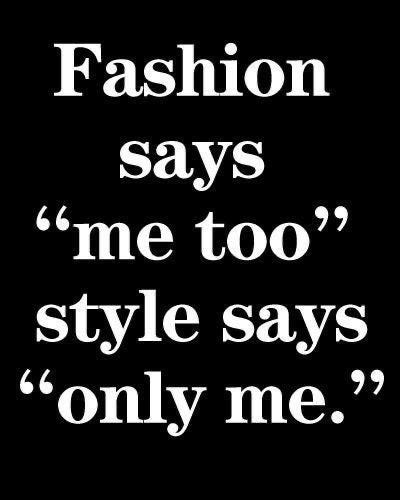The Problem with the Internet Telling Me What to Wear
Taking back control of our wardrobes in a world driven by digital trends
As the season nears, so do the refurbished tweets from 2011, accompanied by listicles dotted with fall emojis featuring the same old favorites—football games, pumpkin spice lattes, Halloween parties, and so on. Despite platform shifts and app migrations, one thing remains constant: the recycled “fall must-haves.” Dark lipstick, suede boots, cozy sweaters, scarves—it’s all giving “florals for spring—groundbreaking.”
It’s a cycle as reliable as taxes in April, a reminder that the internet often knows very little about the true potential of style. While the intention behind these suggestions might be well-meaning, a 60-second TikTok can hardly guarantee a wardrobe transformation, especially when it’s built on regurgitated trends from a decade ago. Fashion in the digital age is an echo chamber, feeding us the same uninspired ideas. In this hyper-connected world, we’ve lost the plot—and the agency to dress ourselves.
Your wardrobe should feel like an extension of you—a language you use to speak without saying a word. By embracing your own style, you begin to reclaim that narrative, no longer bound by the fleeting nature of trends or the judgment of a digital stranger. Fashion, once a way to connect and inspire, has become prescriptive. Too often, we defer our taste to a 25-year-old in Brooklyn, whose aesthetic feels interchangeable with the next person on the street, while dismissing the bold, “unpalatable” expression of those who dare to be different.
In the words of the late, great André Leon Talley, “Fashion is fleeting. Style remains.” But in today’s algorithm-driven fashion space, commerce dictates the conversation, telling us what to wear based on what’s most profitable. What’s impossible to manipulate through commerce, however, is true personal style.
By grounding your style in timeless, authentic pieces and rejecting the lure of fast fashion, you not only elevate your wardrobe but become part of a global movement to protect the earth. Fashion should serve as a reflection of our values as much as our taste. This rebellion—rooted in intention and authenticity—is one that fashion companies can’t afford to ignore. It’s a quiet yet powerful form of resistance that demands change from the industry. When we make deliberate choices, we force fashion to conform to us, not the other way around.
The obsession with trends has far-reaching consequences. Every year, billions of articles of clothing are produced, many of which go unsold, contributing to over 100 million tons of textile waste. These unsold items are often burned, releasing harmful carbon emissions, warming the planet, and polluting our water and air. In this trend-chasing cycle, the fashion industry has become one of the planet’s biggest polluters, burning fossil fuels at every stage. The fabrics we wear—polyester, nylon, acrylic, spandex—are more than just uncomfortable; they are deadly to the environment.
Of course, the responsibility for change lies with both governments and the fashion industry itself, but consumers can create a groundswell of action from the bottom up. By making mindful choices—curating intentional wardrobes and rejecting the fast-fashion hamster wheel—we drive the shift toward sustainable practices.
Having a well-defined personal style is, in fact, one of the easiest ways to engage in sustainable fashion. A wardrobe rooted in intentionality means fewer impulse purchases, better-quality garments, and a clearer understanding of what truly resonates with you. Diving into the emotional aspect of style: your style should feel like a conversation with yourself, an ongoing dialogue that evolves as you do. When you know your style signatures, fashion becomes less about “what’s in” and more about “what feels like me.” This kind of intentionality helps you build a wardrobe that works for you, rather than you working for your wardrobe.
Style signatures—those consistent elements of your look that are uniquely yours—serve as anchors. Whether it’s a signature red lip, a particular silhouette, or a favorite fabric, these elements help you develop a cohesive, recognizable style. Once you identify your signatures, it becomes easier to curate pieces that serve your personal expression and lifestyle.
Beyond style, this rebellion goes further. By choosing garments made from natural fibers or opting for thrifted and consigned pieces, you reduce your wardrobe’s environmental footprint and become part of a broader, global movement toward a circular fashion economy. The fashion industry is slow to change, but when consumers consistently reject fast fashion and embrace their unique style, we create ripples of transformation that cannot be ignored.
Ultimately, the problem with the internet telling us what to wear is that it lacks context, fueling an environmental crisis that most of us in the West remain blissfully unaware of. But we all feel its impact as temperatures rise. By investing time and thought into our personal wardrobes, we spark a rebellion that demands more from the fashion industry—more responsibility, more integrity, and a future that respects both the planet and individual self-expression.
If you're ready to explore your own style signatures and move beyond the trend cycle, the Style Bible can help you define your unique fashion identity. It’s more than just a guide—it’s a journey of self-discovery, helping you understand the elements that make your style stand out. From silhouettes to fabrics, patterns to color palettes, uncover the pieces that make you feel most authentically you. Take the next step in reclaiming your narrative—because your wardrobe should serve you, not the other way around.








Love love this. Im also an advocate if fashion being a tool for self-discovery and self-expression. Not just clothes to impress or get validation. Fashion has the potential to help us build self awareness, heal the relationship with have with ourselves and our self steam. Im so happy to see more women bring and ecoing this message our there where is needed! 🫶✨thank you for this deep sharing